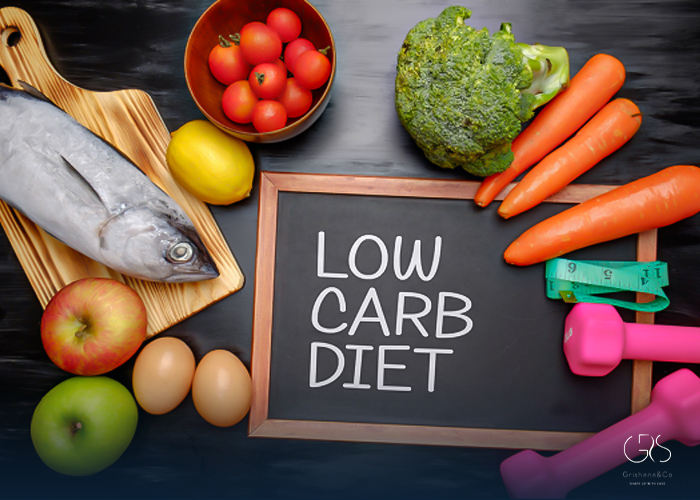The low-carb diet has gained popularity in recent years as a method for weight loss, managing blood sugar levels, and improving overall health. In this comprehensive guide, we will explore how the low-carb diet works, different types of low-carb diets, what to eat, meal ideas, benefits, safety, drawbacks, and conclude with a well-rounded perspective on its efficacy.
How the Low-Carb Diet Works
The low-carb diet focuses on restricting carbohydrate intake and increasing the consumption of proteins, healthy fats, and fiber-rich vegetables. By reducing the intake of carbohydrates, the body shifts from using glucose for fuel to burning fat, resulting in a metabolic state known as ketosis. Ketosis is a natural process where the body produces ketones from stored fat for energy, which can lead to weight loss.

Guidelines of Low-Carb Diets
The guidelines for low-carb diets can vary based on individual goals and health conditions. However, a typical low-carb diet involves limiting carbohydrate intake to 20-50 grams per day, depending on the specific plan. This equates to reducing the consumption of foods like bread, pasta, rice, sugary treats, and starchy vegetables. Instead, the focus is on nourishing the body with whole foods such as lean proteins, seafood, nuts, seeds, healthy fats, and low-carb vegetables.
(To learn about low-carb vegetables, please refer to this article)
Types of Low-Carb Diets
There are several variations of the low-carb diet, each with its own specific guidelines and goals. Some popular types include the ketogenic diet, Atkins diet, low-carb, high-fat (LCHF) diet, and the paleo diet. The ketogenic diet, for example, emphasizes very low carbohydrate intake, typically below 20-50 grams per day, and focuses on high fat consumption to induce and maintain a state of ketosis. In contrast, the Atkins diet involves a phased approach, gradually increasing carbohydrate intake while managing weight loss.
What To Eat on the Low-Carb Diet
When following a low-carb diet, it is important to consume a variety of nutrient-dense foods to ensure optimal health. This includes:
Proteins such as poultry, eggs, fish, and tofu
Healthy fats like avocados, olive oil, and nuts
Non-starchy vegetables such as leafy greens, broccoli, and cauliflower
Berries in moderation for natural sweetness
Dairy products like cheese and yogurt (if tolerated)
(If you’re interested in olive oil or avocado oil , check out this informative article)

Foods Not In the Low-Carb Diet
Foods to avoid on a low-carb diet include:
- Sugary beverages
- White bread, pasta, and rice
- High-sugar fruits like bananas and grapes
- Processed snacks and desserts
- Starchy vegetables including potatoes and corn
- Foods with added sugar and syrups
Meal Ideas for the Low-Carb Diet
Low-carb meals can be both delicious and nutritious. Here’s an example of a day’s worth of meals on a low-carb diet:
For breakfast, enjoy a satisfying egg omelet packed with mushrooms, spinach, and cheddar cheese, served alongside sliced avocado.
At lunchtime, opt for a large green salad as your main course. Top it with flavorful ingredients like salmon, hard-boiled eggs, cucumber, artichoke hearts, cherry tomatoes, pecans, and blue cheese.
For your midday snack, reach for some full-fat Greek yogurt paired with sunflower seeds and a handful of raspberries.
When dinnertime rolls around, savor a hearty bean-less vegetable and turkey chili, which is both satisfying and low in carbs.
To ensure you’re getting enough fiber and essential nutrients, aim to incorporate low-carb vegetables and fruits, such as leafy greens, artichokes, and avocados, into every meal and snack throughout the day. This will help keep your diet balanced and support optimal health.
Benefits of Low-Carb Diets
Low-carb diets have demonstrated a range of benefits beyond weight loss. Research has shown that they may also:
Help With Weight Loss
In a study published in the New England Journal of Medicine, participants on a low-carb diet lost more weight than those on a low-fat diet over a 12-month period. In addition, the low-carb group showed improvements in cardiovascular risk factors.

Improve Blood Sugar Levels
According to the American Diabetes Association, low-carb diets can help manage blood sugar levels by reducing the need for insulin or oral medications in people with type 2 diabetes. This dietary approach may also improve insulin sensitivity and reduce the risk of diabetes-related complications.
Other Benefits
Low-carb diets have been associated with improved triglyceride and HDL cholesterol levels, leading to a reduced risk of heart disease. Furthermore, they have been shown to decrease levels of inflammatory markers in the body, potentially reducing the risk of chronic diseases such as arthritis and cancer.
Is the Low-Carb Diet Safe?
While the safety of low-carb diets has been a subject of debate, numerous studies have provided evidence of their safety and efficacy when followed correctly. However, it is essential to consider potential drawbacks and individual differences.
Drawbacks
Some potential drawbacks of low-carb diets include:
Nutrient Deficiency
Limiting certain food groups can lead to deficiencies in essential nutrients such as fiber, vitamins, and minerals. It is crucial to incorporate a variety of nutrient-dense foods to mitigate this risk.
Adverse Effects
Transitioning to a low-carb diet may lead to short-term side effects known as the “keto flu,” which can include headaches, fatigue, and irritability. These symptoms usually resolve within a few days to a couple of weeks as the body adapts to burning fat for fuel.
Sustainability
For some individuals, maintaining a low-carb diet long-term can be challenging and may lead to feelings of deprivation or social isolation. It is essential to find a balance that is sustainable and enjoyable in the long run. (10)
Conclusion
The low-carb diet offers a structured approach to managing weight, blood sugar levels, and overall health. By understanding the principles, guidelines, types, and potential benefits, individuals can make informed decisions about incorporating a low-carb diet into their lifestyle. It is crucial to consider individual preferences, health status, and potential drawbacks for a well-rounded approach to dietary choices.
In conclusion, the low-carb diet can be a valuable tool for those seeking to improve their health and well-being. When followed responsibly and with attention to individual needs, it can be a sustainable and effective strategy for managing weight and promoting metabolic health.
Sources
- Medical News Today, What can you eat on a low-carb diet?
- New England Journal of Medicine, Weight Loss with a Low-Carbohydrate, Mediterranean, or Low-Fat Diet
- American Heart Association, Carbohydrates
- Healthline, 14 Foods to Avoid (or Limit) on a Low-Carb Diet










